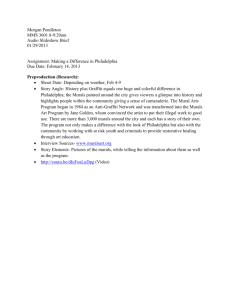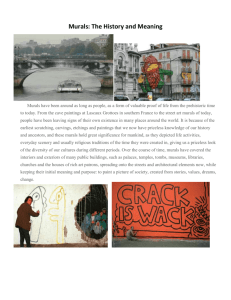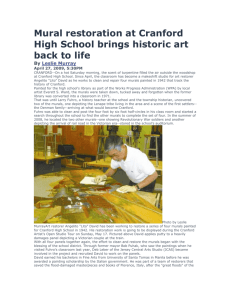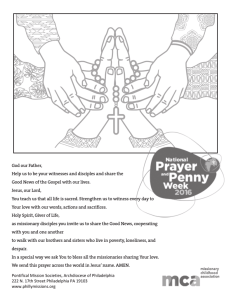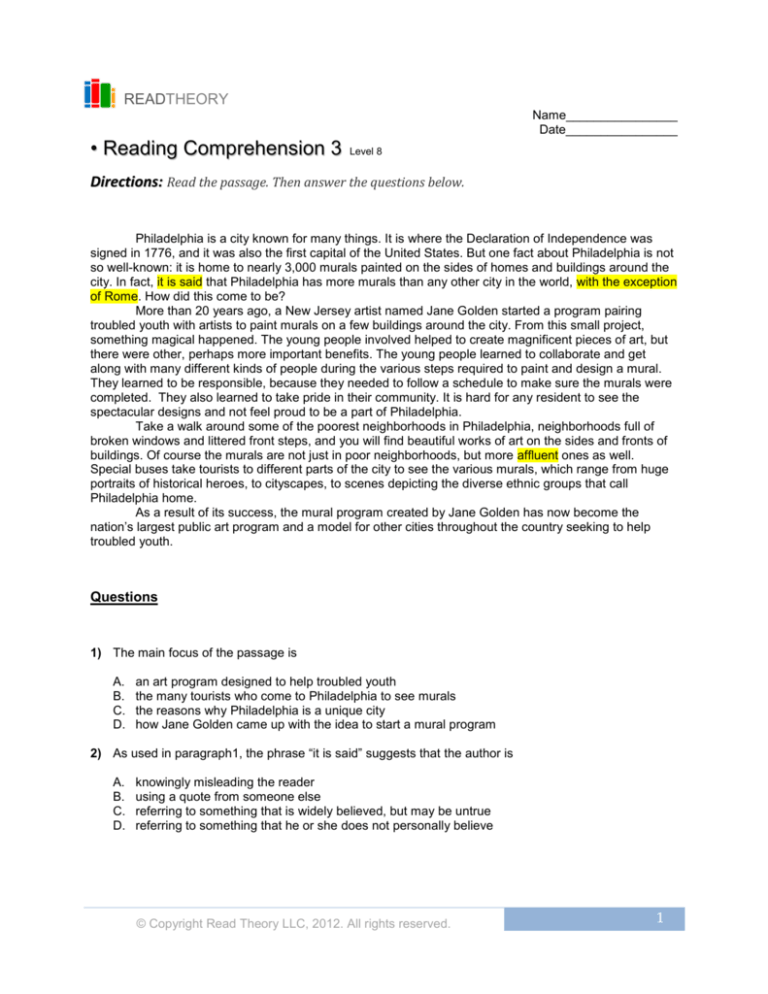
READTHEORY
Name________________
Date________________
• Reading Comprehension 3
Level 8
Directions: Read the passage. Then answer the questions below.
Philadelphia is a city known for many things. It is where the Declaration of Independence was
signed in 1776, and it was also the first capital of the United States. But one fact about Philadelphia is not
so well-known: it is home to nearly 3,000 murals painted on the sides of homes and buildings around the
city. In fact, it is said that Philadelphia has more murals than any other city in the world, with the exception
of Rome. How did this come to be?
More than 20 years ago, a New Jersey artist named Jane Golden started a program pairing
troubled youth with artists to paint murals on a few buildings around the city. From this small project,
something magical happened. The young people involved helped to create magnificent pieces of art, but
there were other, perhaps more important benefits. The young people learned to collaborate and get
along with many different kinds of people during the various steps required to paint and design a mural.
They learned to be responsible, because they needed to follow a schedule to make sure the murals were
completed. They also learned to take pride in their community. It is hard for any resident to see the
spectacular designs and not feel proud to be a part of Philadelphia.
Take a walk around some of the poorest neighborhoods in Philadelphia, neighborhoods full of
broken windows and littered front steps, and you will find beautiful works of art on the sides and fronts of
buildings. Of course the murals are not just in poor neighborhoods, but more affluent ones as well.
Special buses take tourists to different parts of the city to see the various murals, which range from huge
portraits of historical heroes, to cityscapes, to scenes depicting the diverse ethnic groups that call
Philadelphia home.
As a result of its success, the mural program created by Jane Golden has now become the
nation’s largest public art program and a model for other cities throughout the country seeking to help
troubled youth.
Questions
1) The main focus of the passage is
A.
B.
C.
D.
an art program designed to help troubled youth
the many tourists who come to Philadelphia to see murals
the reasons why Philadelphia is a unique city
how Jane Golden came up with the idea to start a mural program
2) As used in paragraph1, the phrase “it is said” suggests that the author is
A.
B.
C.
D.
knowingly misleading the reader
using a quote from someone else
referring to something that is widely believed, but may be untrue
referring to something that he or she does not personally believe
© Copyright Read Theory LLC, 2012. All rights reserved.
1
3) As used in paragraph 1, the phrase “with the exception of Rome” means that
A.
B.
C.
D.
Rome has fewer murals than Philadelphia
Philadelphia has fewer murals than Rome
Rome has the most beautiful murals of all
Rome and Philadelphia are the only cities with murals
4) According to the passage, the murals in Philadelphia
I. draw tourists who want to see them
II. instill responsibility and pride in the people who paint them
III. are solely designed by the youth who paint them
A.
B.
C.
D.
I only
I and II only
II and III only
I, II, and III
5) As used in paragraph 3, which is the best definition of affluent?
A.
B.
C.
D.
popular
clean
well-known
wealthy
6) Based on information in the passage, the author most likely believes that
A.
B.
C.
D.
there are too many murals in Philadelphia
the mural program was an inspirational idea
all troubled youth should learn how to paint
every city in the country should adopt the mural program
7) Based on information in the passage, it can be inferred that the author believes the two best reasons
for other cities to adopt the mural program are to
A.
B.
C.
D.
beautify their city and draw tourists
help troubled youth and beautify their city
have as many murals as Philadelphia and help troubled youth
draw tourists and surpass Philadelphia in terms of number of murals
8) In order to make this passage more engaging to readers, the author could have included
I. a brief history of Philadelphia
II. pictures of some of the murals
III. an interview with a program muralist
A.
B.
C.
D.
I only
I and II only
II and III only
I, II, and III
© Copyright Read Theory LLC, 2012. All rights reserved.
2
Answers and Explanations
1) A
The main focus of a passage is the controlling idea. To identify the controlling idea, it is helpful to review the content and structure of
the passage. Paragraph 1 introduces a little-known fact about Philadelphia: that “it is home to nearly 3,000 murals painted on the
sides of homes and buildings.” Paragraph 2 explains that these murals are the product of an art program designed to pair “troubled
youth with artists.” It also identifies some of the benefits for the community in addition to the art. Paragraph 3 describes where the
murals are and what they depict. Paragraph 4 states that the art program has gone on to become “the nation’s largest public art
program and a model for other cities.” From this information we can understand that the main focus of the passage is the formation
of an art program designed to help troubled youth and its effects on the community. Therefore (A) is correct. Paragraph 3 mentions
the tourists who come to see the murals, but because that is only one small detail in the passage, it is not the main focus. This
makes (B) incorrect. Only paragraph 1 mentions well-known facts about Philadelphia; the rest of the passage focuses on the art
program rather than the reasons why Philadelphia is unique. This means (C) is incorrect. Although Jane Golden is mentioned in the
passage, it does not contain information about how she came up with her idea, so (D) is incorrect.
2) C
In paragraph 1, the author states that Philadelphia is “home to nearly 3,000 murals.” Next, the author writes, “In fact, it is said that
Philadelphia has more murals than any other city in the world, with the exception of Rome.” The author does not offer this statement
as absolute truth. We can infer that the author has not personally counted all the murals in both Philadelphia and Rome—perhaps
no one has. Yet the phrase “it is said” implies that this is a statement that is often repeated by people, so while it may not be true, it
is widely believed. Therefore (C) is correct. Though the author may not know for sure whether this statement is true, there is no
evidence in the passage that he or she is knowingly misleading the reader. Rather, the author uses the phrase “it is said” to
acknowledge that he or she cannot verify the statement as fact. This disclosure is an attempt to be straightforward with the reader,
not misleading. This makes (A) incorrect. If the statement were a quote from someone else, it would most likely appear in quotation
marks and be attributed to a specific person. This means (B) is not the best choice. Although the statement might not be true, there
is no sarcasm to suggest that the author does not believe it. Instead, it is a piece of information which, though unverified, is offered
in good faith. This means (D) is incorrect.
3) B
In paragraph 1, the author states, “It is said that Philadelphia has more murals than any other city in the world, with the exception of
Rome.” From this information we can understand that Philadelphia has the most murals except for Rome, or in other words, Rome is
the only city which has more murals than Philadelphia. Another way to say this is that Philadelphia has fewer murals than Rome.
This means (B) is correct. The passage does not contain information to support choices (A), (C), and (D). Therefore they are
incorrect.
4) B
In paragraph 3, the author states, “Special buses take tourists to different parts of the city to see the various murals.” From this we
can understand that the murals are a tourist attraction, which means that they draw tourists to the city. This supports option (I). In
paragraph 2, the author claims that the young people “learned to be responsible, because they needed to follow a schedule to make
sure the murals were completed,” and “they also learned to take pride in their community.” This information supports option (II).
Although in paragraph 2 we learn that the youth participate in “the various steps required to paint and design a mural,” the passage
also tells us that the program is a joint effort between the youth and artists, so there is no evidence that the murals are solely
designed by the youth who paint them. This eliminates option (III). Therefore (B) is correct.
5) D
affluent (adjective): having a great deal of money; wealthy.
In paragraph 3, the author writes, “Of course the murals are not just in poor neighborhoods, but more affluent ones as well.” From
this sentence we can understand that affluent is the opposite of poor. The opposite of poor is wealthy, so (D) is correct. Popular is
not the opposite of poor, so (A) is incorrect. Though the passage describes the poor neighborhoods as “full of broken windows and
littered front steps,” it is not true that poor and “littered,” meaning dirty, are synonyms. Therefore clean cannot be the opposite of
poor, which means (B) is incorrect. Well-known is not the opposite of poor, so (C) is incorrect.
6) B
When the author first describes the art program in paragraph 2, he or she states, “From this small project, something magical
happened.” The author continues to say that the project created “magnificent pieces of art,” but that it also had “other, perhaps more
important benefits.” These benefits include the young people involved learning to “collaborate,” to be “responsible,” and to “take
pride in their community.” In paragraph 4, the author informs us that “as a result of its success, the mural program created by Jane
Golden has now become the nation’s largest public art program and a model for other cities throughout the country seeking to help
troubled youth.” Based on words like “magical” and “magnificent,” we can infer that the author has a positive view of the program
and its effects on the community of Philadelphia. Since the author thinks the program is a good thing, he or she most likely believes
that it was an inspirational idea. Therefore (B) is correct. Although in paragraph 1 the author states that there are lots of murals in
Philadelphia, there is no information in the passage to imply that the author thinks there are too many murals. Therefore (A) is
incorrect. In paragraph 2, the author describes the benefits for the young people who became involved in the mural project, but it is
too extreme to infer that the author thinks all troubled young people should learn how to paint. There are many reasons why learning
to paint would not help some troubled young people. For example, they may not like painting, or they may face challenges in their
lives which cannot be fixed through a mural project. This means (C) is incorrect. In paragraph 4, the author states that the program
has become a “model for other cities,” but this is a fact, not an opinion. The author does not imply that every city should adopt the
mural program. This means (D) is incorrect.
© Copyright Read Theory LLC, 2012. All rights reserved.
3
7) B
Paragraph 2 details the benefits of this program. The author states that the first benefit is the creation of “magnificent pieces of art,”
but that there are other benefits for the community. The author notes that the young people involved learn to “collaborate,” to be
“responsible,” and to “take pride” in their city. Indeed, paragraph 4 describes Philadelphia’s program as “a model for other cities
throughout the country seeking to help troubled youth.” From this we can infer that the two main accomplishments of this program
are the beautification of the city and the help for troubled youth. This suggests that the two best reasons for other cities to begin a
similar program are to help troubled youth and to beautify their cities. Therefore (B) is correct. While the program in Philadelphia
does beautify the city and draw tourists, the author claims that “perhaps more important benefits” are the lessons learned by the
youth involved. Since (A) does not include what is, in the author’s view, the most important reason to begin such a program, it is
incorrect. Helping troubled youth is a good reason for other cities to begin similar programs, but there is no information in the
passage to suggest that other cities would try to compete with Philadelphia for the highest number of murals. This makes (C)
incorrect. While the murals do draw tourists, according to the passage this is not one of the most important benefits. Also, there is
no information in the passage to suggest that other cities would try to compete with Philadelphia for the highest number of murals.
This makes (D) incorrect.
8) C
Although the author mentions some historical facts about Philadelphia in paragraph 1, the focus of the passage is on the mural
program, not Philadelphia’s history. A piece of writing is most engaging when it remains focused on the main topic, so including a
brief history of the city would make the passage less focused and therefore less engaging. This eliminates option (I). In paragraph
3, the author describes the images on the murals as ranging “from huge portraits of historical heroes, to cityscapes, to scenes
depicting the diverse ethnic groups that call Philadelphia home.” To support this description and help readers visualize the murals,
the author could have included pictures of some of the murals. Seeing the murals for themselves would make this passage more
engaging to readers, so this supports option (II). Paragraph 2 describes the skills and lessons learned by the troubled youth
involved in the mural program. Hearing one of the young people describe these teachings in his or her own words would not only
add credibility to the author’s claims, but it would also be more engaging for the readers to hear a different voice. This supports
option (III). Therefore (C) is correct.
© Copyright Read Theory LLC, 2012. All rights reserved.
4

